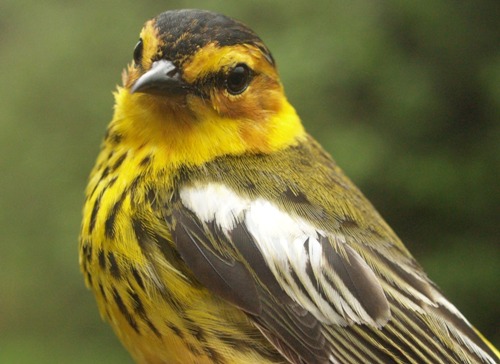|
|
THIS WEEK |
THIS SPRING |
2012 TOTAL |
SITE TOTAL |
# birds (and species) banded |
221 (40) |
536 (53) |
611 (55) |
36363 (108) |
# birds (and species) repeat |
64 (17) |
152 (22) |
166 (25) |
6579 (69) |
|
# birds (and species) return |
28 (8) |
77 (13) |
103 (14) |
1064 (38) |
|
# species observed |
96 |
129 |
130 |
205 |
|
# net hours |
467.0 |
1610.0 |
1674.8 |
60772.9 |
|
# birds banded / 100 net hours |
47.3 |
33.3 |
36.5 |
59.8 |
|
|
Note: table does not include nocturnal banding (owls) |
Banders-in-charge: Simon Duval, Gay Gruner
Assistants: Christine Barrie, Richard Beauchamp, Nicolas Bernier, Cindy Bouchard, David Davey, Rui De Jesus, Leah den Besten, Tammy Elliot, Jessica Fiset, Barbara Frei, Liette Fortier, Louise Gagné, Nathalie Gendron, Alison Hackney, James Junda, Catherine Langevin, Barbara MacDuff, Francine Marcoux, Betsy McFarlane, Sabrina Rochefort, Catherine Russell, Marilou Skelling, Jane Sorensen, Elise Titman, Jay VanderGaast, Monique Venne, Yifu Wang
Notes: Our successful spring season continued this week, with numbers across the board again well above average compared to our previous seven years. The weather was generally cooperative this week, with only Sunday partly compromised by rain. The number of birds banded this week is the second highest ever for spring, and our cumulative total to date of 535 is far ahead of the previous record of 479 at this point in the season. Repeats and returns are also on a record pace - it is too early to know whether these trends will continue to the end of spring, but so far we are very pleased with the results! Species diversity remains well above average too, with the 96 species observed this week just ahead of the previous week 7 record of 95 in 2009, and the season total of 127 just one behind the pace of that same year. The daily estimated total peaked this week at 70 species on May 12, the third highest single-day total ever at MBO (behind 71 on May 30, 2007, and 75 on May 18, 2009). The rest of the week was good too, with daily counts ranging from 47 to 66 species, including as many as 16 warbler species in a single morning.
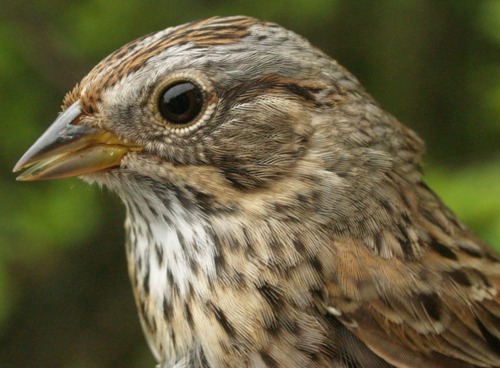
Lincoln's Sparrow is an uncommon spring migrant at MBO, with only 38 banded over the previous 7 years - but this week alone we banded 6 individuals. Most looked like the one above, but we also had an unusually pale individual, shown below.
(Photos by Simon Duval)
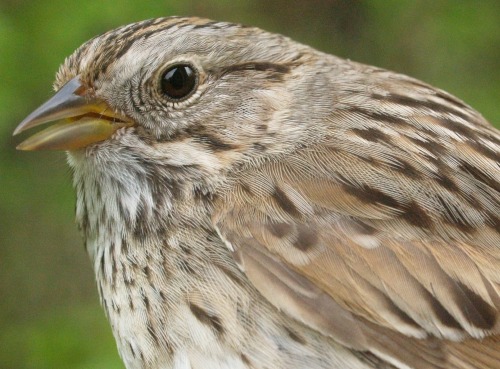
|
It was another busy week for new arrivals, with 22 more species recorded for the first time this year - 3 waterbirds (Cackling Goose, Pied-billed Grebe, Spotted Sandpiper), 2 raptors (Bald Eagle, Peregrine Falcon), 2 flycatchers (Least and Traill's), 2 vireos (Red-eyed and Philadelphia), 3 thrushes (Veery, Wood Thrush, Eastern Bluebird), 7 warblers (Northern Parula, Black-and-white, Cape May, Blackburnian, Chestnut-sided, Bay-breasted, and Wilson's), 2 finches (Rose-breasted Grosbeak and Indigo Bunting), and a sparrow (Lincoln's). Similarly, our list of species took a giant leap forward this week to a total of 53 - a full eight species ahead of our previous record pace in 2008. The 20 species added this week comprised 2 flycatchers (Least and Traill's), 2 thrushes (Veery and Wood Thrush), 2 mimids (Gray Catbird and Brown Thrasher), 10 warblers (Northern Waterthrush, Tennessee, American Redstart, Black-and-white, Cape May, Black-throated Blue, Magnolia, Chestnut-sided, Common Yellowthroat, and Wilson's), 3 sparrows (Lincoln's, White-crowned, and Slate-colored Junco), plus Rose-breasted Grosbeak. Also of note this week we had a repeat Rusty Blackbird, the first time ever that we have had one hang around at MBO and get recaptured.
This week’s
top 10 [last week's rank in brackets]
#
individuals banded |
mean # individuals observed daily |
1. Yellow-rumped Warbler (41) [10] |
1. Canada Goose (128) [1] |
2. Red-winged Blackbird (19) [1] |
2. Red-winged Blackbird (58) [2] |
3. Tennessee Warbler (16) [-] |
3. Ring-billed Gull (43) [7] |
4. Yellow Warbler (13) [7] |
4. American Crow (30) [3] |
5. Ruby-crowned Kinglet (10) [3] |
5. Yellow Warbler (21) [-] |
5. Nashville Warbler (10) [7] |
6. Baltimore Oriole (18) [-] |
7. Magnolia Warbler (8) [-] |
7. Common Grackle (17) [6] |
7. White-crowned Sparrow (8) [-] |
8. Yellow-rumped Warbler (16) [-] |
9. Warbling Vireo (6) [10] |
9. Greater Snow Goose (14) [-] |
9. Gray Catbird (6) [-] |
10. Black-capped Chickadee (14) [4] |
9. Northern Waterthrush (6) [-] |
|
9. Lincoln's Sparrow (6) [-] |
|
9. Baltimore Oriole (6) [-] |
|
|
We often see rather gradual transitions in species dominance as the season progresses, but this week we saw some rather substantial contrasts compared to last week, with 8 species dropping off from last week's list of top species banded, and seven new entries this week (the discrepancy accounted for by both weeks having a five-way tie at the bottom of the list, but for 9th place this week and 10th last week). Yellow-rumped Warbler jumped from last week's tenth place tie to take top spot this week with more than twice as many individuals as Red-winged Blackbird in second - and this is the second highest weekly total ever for Yellow-rumped Warbler in spring. The total number of Red-winged Blackbirds for this spring is now up to 103, already the best season total since 2008, and with more likely yet to come. Perhaps the biggest surprise this week was the unusually early influx of Tennessee Warblers, since over our previous 7 spring programs, we have banded a grand total of just 3 individuals in week 7, compared to 16 this year! Other noteworthy species in this week's list include Warbling Vireo (more banded this week than in any full spring season since 2007), and Lincoln's Sparrow (a single week record for spring). Dropping off the list were four of last week's top six species (Tree Swallow, White-throated Sparrow, Common Grackle, American Goldfinch), as well as Yellow-bellied Sapsucker and three sparrows (Chipping, Song, Swamp).
The transition was a bit less dramatic among species observed, with only four new entries to the top ten this week. Canada Goose and Red-winged Blackbird continued as the two most dominant species. For Canada Goose, this marks the fourth year in a row topping the list for week 7, a sharp contrast to our first four spring monitoring programs, when it ranked between second and ninth in three years, and missed the top ten entirely in 2006 - it certainly seems that there has been a change in their spring movement patterns over this short period. Continuing the trend of early migrants, the mean daily count of 21 Yellow Warblers is the highest we have ever recorded for week 7, and this is only the fifth time in eight years that the species has been among the ten most frequently observed birds at this point in spring (and the first time in the top five). Conversely, this is the latest in spring that we have ever seen Snow Geese - further evidence of the complexities of migration! Species displaced from last week's top ten were Mallard, Tree Swallow, Ruby-crowned Kinglet, and White-throated Sparrow.
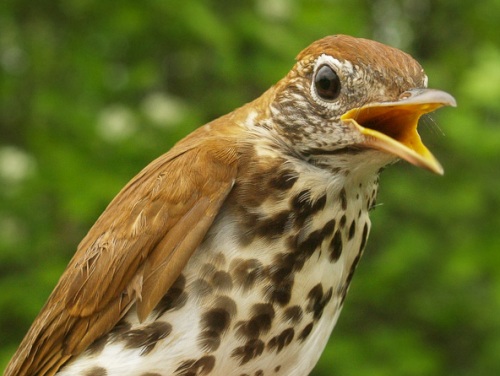
This Wood Thrush banded on the final day of this week was only the fifth ever banded at MBO, and just the second in spring, the previous one coming in May 2010.
(Photos by Simon Duval)
|
It's hard to believe, but we already are down to our final three weeks of spring migration! Week 8 has on average been our busiest week of the season, so we are hoping that weather holds up and that the results so far this season are a promising indicator of what is awaiting us next....
|
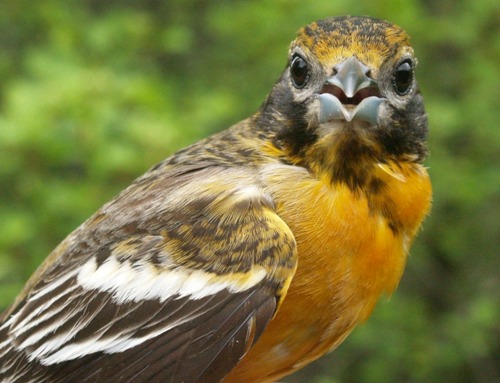
Although superficially easy to age and sex, Baltimore Orioles can sometimes prove tricky even for experienced banders. After some deliberation, we concluded this is an after-second-year female, based on the lack of molt limits on the wing and a relatively dark head.
(Photos by Simon Duval)
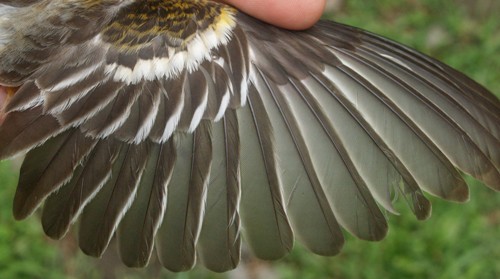
|

